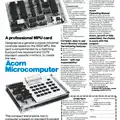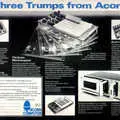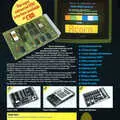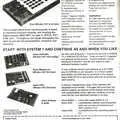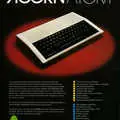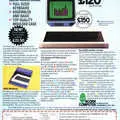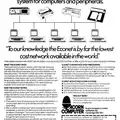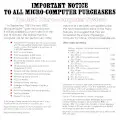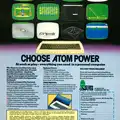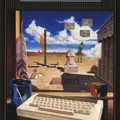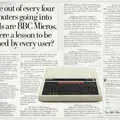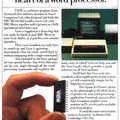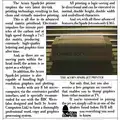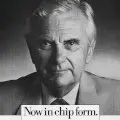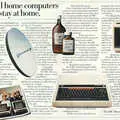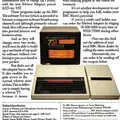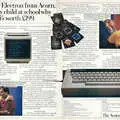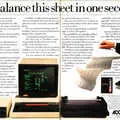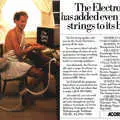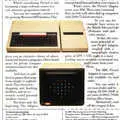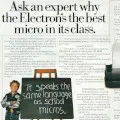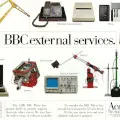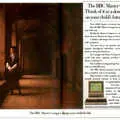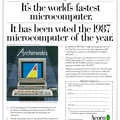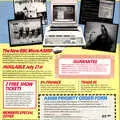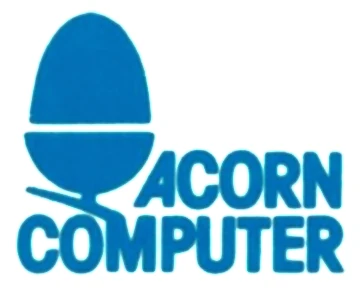
Acorn Advert - November 1986
From The Micro User
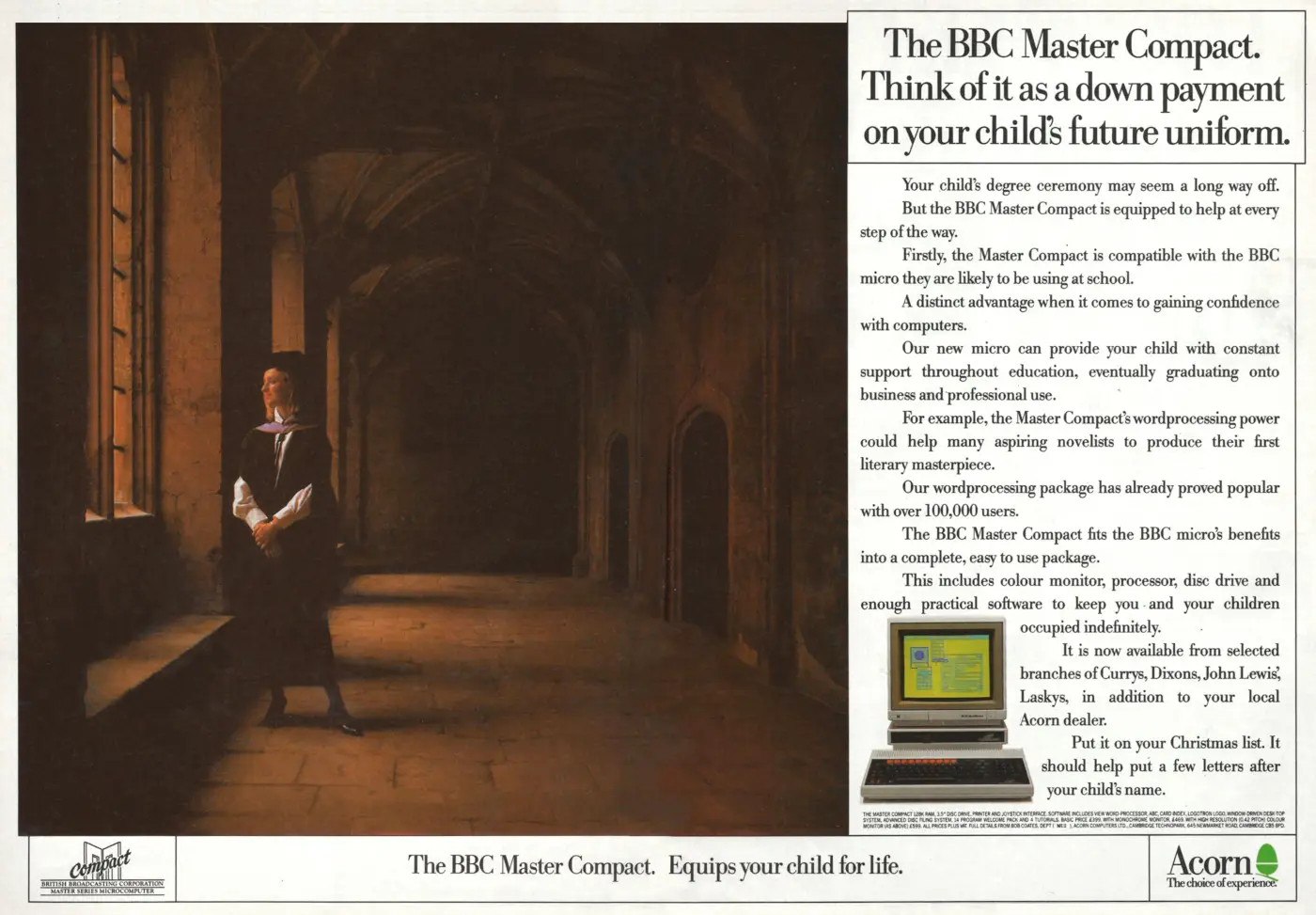
The BBC Master Compact: Think of it as a down payment on your child's future uniform
The BBC Master Compact was an entry in the BBC Master series, which in turn was produced as the follow-up to the BBC Model 'B' Micro.
It was designed jointly by Acorn and design consultants David Morgan Associates, a company which had already designed the Communicator, the network all-in-one micro built around the BBC B which was sold by spin-off company Torch. David Bell, BBC Products Manager at Acorn added:
"Design objectives, while working within the confines of cost and time limitations, were to produce a product which was aesthetically comfortable in the office, home or school environment and which would complement its surroundings"[1].
Early design discussions for the Master series had included the suggestion that the machine should switch to a two-piece casing, with a separate keyboard.
However it was decided that the range should continue to look as much like the old BBC Micro as possible, to ensure "philosophical compatibility". This included keeping the colour of the case the same.
There were some subtle changes, including raising the pitch of the keyboard to make its key labels easier to read, and adding a 19-key numeric keypad. Despite the addition to the keyboard - which was the same as the Acorn Cambridge Workstation - the original Master still had a smaller footprint than an IBM PC[2].
Sticking with the 6502
The bigger question was why the Master design stuck with the 6502 processor of its forebears, at a time when 16- and 16/32-bit chips like Motorola's 68000 series, or Intel's 8086 or even 80186 were, or were becoming, popular.
There were issues with Intel processors, as while both the 6502 and 8086 were interrupt controlled, the 8086 was considered too slow - even when on paper it was supposedly at least twice as fast.
Furthermore, the address space of the 8086 and its ilk was chunked into 64K segments, meaning any software written using Microsoft's BASIC was limited to around 59K. This 64K limit was no better than that available in 8-bit machines.
Processors like the 68000 and National Semiconductor's 32000 family didn't have the 64K block limit, but were fundamentally incompatible with the 6502 on a machine-code level, so they were out of the running too as that would rule out much of the commercial software by now available in the BBC ecosystem.
Another option for Acorn had been Western Design Center's 65C618 processor, which was perfectly compatible with the older 6502 when run in emulation mode.
However, even this proved to be largely incompatible in 16-bit mode, and also slower than a native 6502, partly because its address space in 16-bit mode was also divided into segments of 64K[3].
Perhaps the bigger issue though was that at the design stage it was uncertain as to whether WDC's processor would actually be available in quantity within the required timescale.
So for these reasons it was not chosen for the Master series, although it did get used in the later Acorn/Torch Communicator micro, as well as Apple's IIGS.
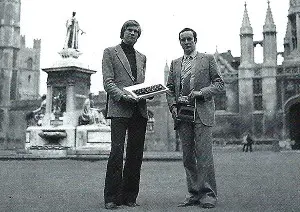
Hermann Hauser and Chris Curry pause for a photo in 1980 with their Atom on the lawn in King's College Great Court, Cambridge. © Acorn User, August 1984There had been several models of BBC Micro in between the Master Compact and the original and famous BBC B, including the less-successful BBC B+, and a range of 128K BBCs launched at the beginning of 1986.
The "standard" BBC Master replacement machine in the range ran the 2MHz 65C12 CMOS version of the 6502 and was "about 80% compatible" with the B+.
Despite sticking with 8-bit technology, the new version of BBC BASIC developed for it - BASIC IV - ran the Personal Computer World benchmarks 60% faster than the original BBC, at around 9.2 seconds.
That compared favourably with IBM's latest-and-greatest PC AT, which clocked in only two seconds faster at 7.11 seconds[4], despite running an Intel 80286.
Also in the range was a 512k model which ran MS-DOS and a 32-bit 32016-based micro, intended for scientific and research use thanks to its £1,000 price tag[5].
Although this latest Master Compact range was also broadly compatible with older software - it ran the similar but upgraded 65SC12 processor, now at 4MHz - the Compact used the relatively new 3½" floppy drive format which meant that not much commercial software was ever released for it[6].
It was however notable for including Acorn's first release of its graphical user interface.
Despite the incompatibilities, the Master range itself was quite successful and was produced up until 1994 - the same year that Commodore finally went bust after over twenty years in the technology business.
The machine also reviewed well, being seen as part of a range that had an excellent reputation for quality and reliability. Gordon Taylor, writing in Personal Computer World, concluded:
"It has been possible to increase production of the Master series far more quickly than with the original [BBC Micro] machines, which is just as well, as many would-be users believe that the Master Series represents excellent value for money. Demand is again higher than expected, and there are prospects of quantity orders from OEMs[7]".
The decline of Acorn?
The modest success of the Master was somewhat bitter-sweet, at least for Popular Computing Weekly, which saw the machine as marking the decline of Acorn from its position as one of Britain's most highly-regarded manufacturers to a minor role as a seller of specialist machines to the educational sector.
The magazine lamented how the success of the BBC Micro in the UK had failed to be matched in any of the export markets that Acorn had attempted to conquer.
It also noted how BBC compatibility had become a millstone for the company, becoming an end in itself rather than as simply a useful feature, and the only real development that Acorn still had up its sleeve - the RISC chip - still looked to be a further two years away[8].
Acorn's marginalisation was worsened when its parent company, Olivetti, chose its US partner AT&T to launch its M19 MS-DOS-compatible micro into the education market, instead of promoting the Master.
This was in part a response to the Italian government's mandating of MS-DOS as an educational standard, which ruled out the DOS-Plus-running Master 512 as it was not entirely compatible.
Whilst Olivetti staff had been quoted as saying that the BBC series had a "valuable software library", it also conceded that Acorn's hardware base was "a real problem"[9].
Meanwhile, the advert itself features a nice, sepia shot of some college girl staring wistfully out of the cloisters at an undoubtedly Cambridge college.
Acorn's founders Chris Curry and Hermann Hauser had met whilst the latter was doing a post doctorate at Cambridge University's Cavendish Physics Laboratory, whilst Acorn's first offices were on Market Hill - close to King's College in the centre of Cambridge - and several of their engineers were hired straight out of the university.
Acorn back in the black
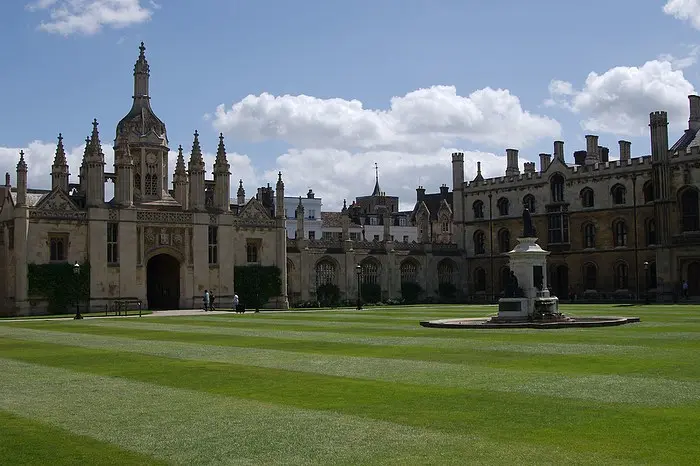
King's College Great Court, Cambridge in 2015, © nosher.netAt the same time as the advert appeared in Acorn-friendly "The Micro User", Acorn announced that after two years of serious financial problems, which saw it bailed out by Italian typewriter company Olivetti early in 1985, it was back in the black, with operating profits of £298,000 in the first six months of 1986.
This compared to a loss of £25 million (about £100 million in 2025) the year before and seemed to take some industry observers by surprise, as the company had been written off by several in the press the year before.
The turnaround was also achieved without cutting back on R&D - chairman Alex Uboldi said "We haven't sacrificed a single element of our longer-term policy to achieve the turnaround ahead of schedule" and was helped by good sales of the new BBC Master and Master Compact computers.
New Managing Director Brian Long, who had come from Canadian tractor company Massey Ferguson[10], added:
"Acorn's commitment to continuity sets us apart from our competitors and ensures the sort of loyalty from our customers that is inherent in our success"[11].
This "continuity commitment" even meant that even the new Compact remained largely compatible with the original BBC Micro (Acorn Proton) released in 1982.
The news confirmed a change in fortunes that had first tentatively appeared earlier in the spring, when Acorn announced that its losses had been reduced to less than £2 million.
This was made of an operating loss of only £97,000, with the remainder being made up from continuing fall-out from Acorn's disastrous attempts to break the US and German markets, plus a £345,000 set-aside towards a six-month-old Inland Revenue VAT investigation which was due to conclude in May and which had been triggered when the company "failed to provide accurate records for the previous year".
It was not all good news though, as Acorn's single BBC-endorsed line of micros was still accounting for around 90% of its entire turnover, whilst potential returns from its RISC research and its spin-off Communicator, made by Torch, had yet to appear. An Acorn spokesman stated:
"The Master series will remain our bread and butter for a time. RISC development will not be coming through until next year. The Communicator is not engendering any revenue now, and won't be for the first six months of the year. However, particularly encouraging is the interest shown in the Communicator by Olivetti UK, which sees it as a potential product in the financial market"[12]
Acorn was not especially known for price cutting, but the Master Compact did get a little trim in the summer of 1987, following the launch of the company's next big thing: the Archimedes.
The Compact's price was trimmed from £551 to £469 for the monochrome version and £704 to £645 for the colour model, whilst Acorn's PR head Michael Page was denying that this marked the replacement of the Master range by the Archimedes, saying that "We see that existing machines are very much part of a coherent range meeting needs in specific areas" before saying that "Because we see the Master as continuing to sell, we had to adjust the prices"[13].
Not by too much though.
Rumours of an Olivetti ARM takeover
Meanwhile, in the US, production had started under licence of the fruit of Acorn's recent research - its RISC (Reduced Instruction Set Computing) chip, otherwise known as the Acorn RISC Machine, or ARM, which would end up in the upcoming Acorn Archimedes range of computers.
The RISC project was fundamental to the future success of Acorn, but the following year, in May 1987, there were rumours - reported by Personal Computer World's Guy Kewney - that a simple plan "not yet given the go-ahead [is to] close down Acorn and run the ARM project from inside Olivetti".
There were also further claims that Olivetti had only ever invested in Acorn to get the people who were designing the Acorn RISC Machine, and that this was the only reason the BBC contract was kept going.
This was vigorously denied by Acorn, whose spokesman Michael Page said:
"whispers from echoes in boardrooms are never as reliable as being in the boardroom itself - Olivetti has no desire to close Acorn down. What it has said is that it would be quite content to see its shareholding reduced at some point in the future"[14].
It's interesting to speculate what might have come of the now-multi-£billion company ARM had Olivetti shut Acorn down and all the engineers had left in protest.
Whatever the closing-down rumours, co-founder Chris Curry had already set up a new company by the end of 1985.
General Information Systems (GIS) was based in Acorn's Communications Group, and had already released the Red Box range of mains-electricity-networked control peripherals in 1986.
By the end of 1987, the company was working on VLSI chip design for Curry's next big thing, the Keyline computer, which was:
"[a] highly intelligent but inexpensive portable computer terminal which is designed to replace Yellow Pages, hook into all your favourite retailers like supermarkets and high-street chains and even access on-line bank accounts".
In a nod to the credit-card model, Curry hoped to make the Keyline so cheap that it could be given away and funded by a small fee on every financial transaction made, with estimates of half a million machines by the end of 1989 and several million in the following years.
However as of December 1987, Curry was still looking for the £20 million finance required to get the project rolling.
The idea was not unlike the French Minitel, and similarly was expected to run with the co-operation of state telecomms operator British Telecom, as well as high-street chains.
With artificial-intelligence-based software, Curry was hoping that:
"anyone with a modicum of sense [could use] the computers without techno-fear and [get] a genuine use from the technology"[15].
Job losses at Acorn
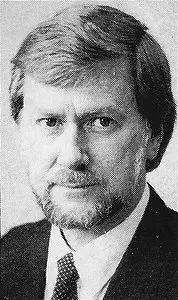
Brian Long, MD of Acorn. © Acorn User, November 1985At about the same time in the December of 1987, Acorn itself was having another re-shuffle, as it made 47 of its 300 staff redundant in "an attempt to restructure the company", with Acorn's PR spokesperson Michael Page keen to point out that the job losses were "due to a change in business operations".
The job losses were in the custom-made products side of the business, which - according to dealers who were anomymously contacted - was a popular feature but which was not producing the required financial returns. Page continued:
"We will no longer produce tailor-made products for individual consumers; we shall be producing only volume products"[16].
This all followed on not long after MD Brian Long had resigned unexpectedly in October, with chairman Bruno Soggiu taking up the role temporarily until a replacement could be found.
Although Long had been unwilling to make any sort of statement on his resignation whilst still at Acorn, it was thought to be in response to another set of disappointing results caused by heavy investment in the Archimedes[17].
Whilst this was going on, Acorn was continuing its involvement in the educational world, as it provided machines for a new high-technology centre, launched by Prince Charles, at Calderdale, just outside Halifax in Yorkshire.
The £8-million centre, targeted at up-to 13 year olds, was aimed at promoting creativity, technology and design, whilst Acorn's senior education advisor Bob Coates pointed out that:
"Acorn's involvement, by virtue of its specialist knowledge in the educational field, will primarily be that of a technological adviser - both in terms of the equipment being featured and the system required to operate it"[18].
No wonder that the centre's first machine was an Archimedes.
Hermann Hauser branches out
By the end of the 1980s, magazines like Personal Computer World had closed the book on the native British computer industry, in a world which was now entirely dominated by either American companies like Dell and IBM at the branded end of the market, or a vast swathe of far-eastern clone manufacturers at the budget end.
Native companies like Amstrad and Acorn were still shifting units, but the glory days were definitely talked about in the past tense.
There was however a glimmer of hope in one of Hermann Hauser's new projects.
Formed after Hauser had left his role of director of research and development at Olivetti in 1988, and armed with £1 million of his own money and a 7% stake from Olivetti[19], the new business - Active Book Company - announced a stylus-driven pocket computer called the Active Book in the early summer of 1990 - some seven years before the Palm Pilot launched.
The machine was aimed at "mobile executives" who had been buying what Personal Computer World called "vest-pocket toys" but who were, according to Hauser, likely to find that those machines were:
"really disappointing and that to provide the sort of features they seem to offer, you need enormous amounts of processing power and lots of communications".
Or in other words you couldn't use them for anything except storing a few phone numbers.
Hauser did however have some interesting ideas, a lot of which were informed by what was clearly the first dawning awareness of the coming of the internet and widespread mobile data.
These included the idea of building a cellular phone into every Active Book, which would allow it to connect to every other Book in Europe, or with the owner's own PC in the office.
It was said that this would become a reality within two years because of "the new communications networks that are being set up".
The Active Book was also intending to break away from the Intel hegemony in its use of Acorn's ARM processor, a design choice which at the time seemed more like favouritism for Hauser's old company, or perhaps because he was "biased by a fondness for the brainchild of his friend and protégé Roger (now Sophie) Wilson".
However, in hindsight, it was a remarkably forward-looking choice, as the ARM chip came to utterly own the mobile device market thanks to its high performance combined with low power requirements.
The design also foreshadowed how ARM development in general would go, as the processor merely formed part of a "super-integrated" chip called Hercules, which also included a communications processor, graphics processor, memory manager and all the other logic required, all on a chip smaller than an 80386 whilst rivalling its much bigger rival for performance - much like modern ARM-based "system-on-chip", or SoC, components work today.
In an article entitled "Active Book may re-open British computer industry", Guy Kewney of Personal Computer World suggested that:
"[I'd] like to see a new British computer with the excitement of the original BBC Micro launch, opening up new areas in the reach of technology and new markets ... Experience has taught Hermann Hauser how to market this one too"[20].
Sadly, it didn't come to pass as the Active Book never made it to market, however the company and its ideas were folded into AT&T's EO Personal Communicator project, with Hauser becoming chief technology office of EO's European operation[21][22]
Date created: 11 December 2019
Last updated: 17 October 2025
Hint: use left and right cursor keys to navigate between adverts.
Sources
Text and otherwise-uncredited photos © nosher.net 2025. Dollar/GBP conversions, where used, assume $1.50 to £1. "Now" prices are calculated dynamically using average RPI per year.
